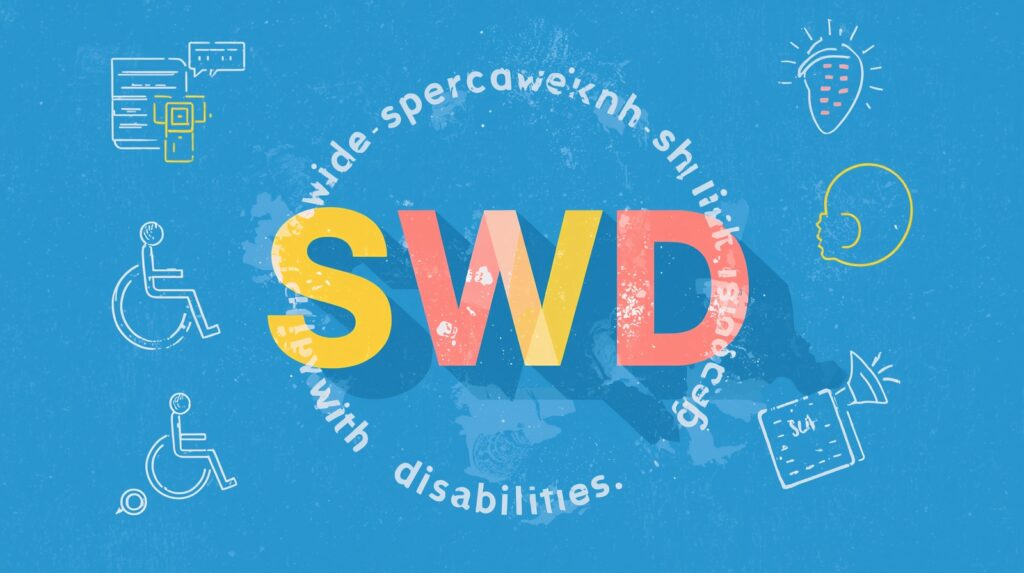
Introduction: Understanding SWD in Special Education
If you are new to the world of special education, you may have come across the term SWD and wondered, “What does SWD stand for in special education?”
The answer is simple: SWD means “Students with Disabilities.”
This short phrase has a big meaning in the education system. It represents millions of learners who have unique learning needs and require special support to achieve their goals. Understanding SWD is important for parents, teachers, and even students themselves because it helps create a fair and inclusive education environment.
In this article, we will explore everything you need to know about SWD in special education — from its definition and legal background to teaching strategies, classroom practices, and common questions. By the end, you will have a clear picture of how SWD impacts education and why it matters for society.
What Does SWD Mean in Special Education?
Definition of SWD
In special education, SWD stands for “Students with Disabilities.”
It is a widely used term in school, colleges, and educational policies to describe learners who have one or more disabilities that affect their ability to learn in a traditional classroom setting.
Types of Disabilities under SWD
Students with Disabilities may include children with:
- Learning disabilities (like dyslexia or dysgraphia)
- Speech or language impairments
- Autism spectrum disorder (ASD)
- Intellectual disabilities
- Emotional or behavioral disorders
- Physical disabilities (hearing, vision, mobility challenges)
- Health-related conditions (like ADHD, epilepsy, or chronic illnesses)
Each student with a disability is unique, and their needs vary. That’s why special education programs are designed to provide individualized support.
Why Is the Term SWD Important in Education?
The phrase “SWD” is not just an acronym — it is a recognition of diversity in education.
- Inclusivity: It reminds schools that every child has the right to learn, regardless of ability.
- Legal Protection: Many laws, like the IDEA (Individuals with Disabilities Education Act) in the U.S., use this term to define rights and services.
- Support Services: It helps educators plan and deliver specific resources, such as Individualized Education Programs (IEPs).
- Awareness: It makes parents and teachers more conscious about the needs of these learners.
History and Legal Meaning of SWD
To understand SWD better, let’s look at how it developed in special education.
Before SWD: Limited Access
Years ago, children with disabilities were often excluded from schools or placed in separate institutions. They did not have equal opportunities to learn.
The IDEA Act
In 1975, the U.S. passed a law known today as the Individuals with Disabilities Education Act (IDEA). This law guaranteed that students with disabilities (SWD) have the right to free and appropriate public education (FAPE).
Global Impact
Today, many countries use similar terms and laws to ensure children with disabilities are included in mainstream schools. The term SWD is now a standard reference in both local and international education systems.
How Do Schools Support SWD?
1. Individualized Education Program (IEP)
An IEP is a custom learning plan designed for each student with a disability. It includes goals, teaching methods, and support services.
2. Classroom Accommodations
Schools may provide accommodations like:
- Extra time for tests
- Assistive technology (speech-to-text software, screen readers)
- Modified assignments
- Preferential seating
3. Special Education Teachers
Teachers trained in special education play a vital role in supporting SWD. They work closely with students, general teachers, and parents to ensure effective learning.
4. Related Services
Support may also include counseling, physical therapy, occupational therapy, or speech therapy depending on the child’s needs.
Challenges Faced by SWD in Schools
Even though progress has been made, students with disabilities still face challenges such as:
- Social stigma or bullying
- Limited resources in some schools
- Teacher training gaps
- Difficulty transitioning from school to work or higher education
Addressing these challenges requires teamwork between schools, families, and communities.
Benefits of Supporting SWD
Supporting students with disabilities benefits everyone, not just the learners themselves.
- For Students: They gain confidence, skills, and a sense of belonging.
- For Teachers: They become more creative and flexible in their teaching methods.
- For Society: Inclusive education produces skilled, independent, and diverse citizens.
Strategies Teachers Can Use to Help SWD
1. Differentiated Instruction
Teachers can adjust lessons to match the learning style of each student.
2. Use of Technology
Assistive technology helps students overcome barriers. For example, screen readers help visually impaired learners, while apps support those with learning difficulties.
3. Positive Reinforcement
Encouraging words and rewards motivate students with disabilities to try harder.
4. Collaboration
Teachers should work with parents, therapists, and counselors to create a strong support system.
Parents’ Role in Supporting SWD
Parents are the strongest advocates for their children. They can:
- Participate in IEP meetings
- Communicate regularly with teachers
- Provide learning support at home
- Encourage social interaction and confidence
Common Myths About SWD
- Myth: Students with disabilities cannot achieve success.
Fact: With the right support, many SWD excel in academics, sports, arts, and careers. - Myth: Special education means “separate” education.
Fact: Most SWD learn in general classrooms with modifications. - Myth: Disabilities only mean physical issues.
Fact: Many disabilities are invisible, like dyslexia or ADHD.
Real-Life Examples of Successful SWD
- Stephen Hawking: Despite a severe disability, he became one of the world’s greatest scientists.
- Helen Keller: Overcame deafness and blindness to become an author and activist.
- Modern Students: Many children with learning disabilities now graduate with honors thanks to inclusive education programs.
These examples show that SWD can achieve greatness when given equal opportunities.
Future of SWD in Education
With the rise of technology and inclusive policies, the future looks bright for SWD:
- More digital learning tools
- Virtual classrooms with accessibility features
- Greater teacher training
- Stronger laws for equality
The focus is shifting from “special” to inclusive education where every child has a place.
Frequently Asked Questions (FAQs) About SWD
1. What does SWD stand for in special education?
SWD stands for Students with Disabilities.
2. Who is considered an SWD?
Any student with a disability that impacts their learning process, including physical, mental, emotional, or developmental conditions.
3. Is SWD the same as special education?
No. SWD refers to the students, while special education is the system of teaching and support designed for them.
4. What rights do SWD have in schools?
They have the right to free and appropriate education, accommodations, and inclusion under laws like IDEA.
5. Can SWD succeed in regular classrooms?
Yes. With the right support, many SWD learn and thrive alongside their peers.
6. Are parents involved in SWD education?
Absolutely. Parents play a key role in planning, advocacy, and emotional support.
7. Do SWD always need special schools?
No. Most SWD can attend mainstream schools with accommodations.
Conclusion: Why Understanding SWD Matters
The question “What does SWD stand for in special education?” goes beyond just three letters. It is about recognizing Students with Disabilities as valuable, capable individuals who deserve equal opportunities in education.
By learning, supporting, and advocating for SWD, we help create an education system that is fair, inclusive, and inspiring for every child.
Whether you are a teacher, parent, or student, understanding SWD is the first step toward a brighter, more inclusive future.





